
Welcome to Hyperion Records, a British classical label devoted to presenting high-quality recordings of music of all styles and from all periods from the twelfth century to the twenty-first.
Hyperion offers both CDs, and downloads in a number of formats. The site is also available in several languages.
Please use the dropdown buttons to set your preferred options, or use the checkbox to accept the defaults.

Spem in alium is written for eight choirs of five voices arranged in an SATBarB line-up. The piece opens with choir 1 (on the left) and moves through each choir in order down to choir 8 (on the right). At bar 40 he allows all forty voices to sound together for the first time before starting with choir 8 and then sweeping all the way back up to choir 1. There then follow several sections where the choirs work in dialogue, throwing the same material from one side to the other in a manner often coloured by imaginative melodic turns in varying voice-parts and punctuated by massive chords for all voices.
The text is a Responsory in the Sarum Rite set to be sung in response to a reading from the Book of Judith in the month of September. It is a prayer for deliverance from the siege which the enemy general Holofernes has laid to the Jewish people of Bethulia. The widow, Judith, saves the situation by making Holofernes drunk, seducing and then beheading him. The Sarum Rite was not in force when Tallis wrote his masterpiece and it is not clear why this text was chosen.
Various ideas have been put forward about why Tallis wrote such a massive piece. The discovery of a manuscript in the hand of Thomas Wateridge suggests there may have been a competitive reason for its composition:
In Queene Elizabeths time there was a songe sent into England of 30 parts (whence the Italians obteyned the name to be called Apices of the world) which beeinge songe made a heavenly Harmony. The Duke of ____ bearinge a great love to Musicke asked whether none of our Englishmen could sett as good a songe, & Tallice beinge very skillfull was felt to try whether he could undertake the Matter, which he did and made one of 40 parts which was songe in the longe gallery at Arundel house which so farre surpassed the other that the Duke hearinge of it songe, took his chayne of Gold from of his necke and putt yt about Tallice his necke and gave yt him (whiche songe was againe songe at the Princes coronation).
This story, told to Wateridge in 1611, probably refers to the visit of Alessandro Striggio (c1536/7–1592) to London in 1567 when one of his forty-part pieces was performed. Wateridge, or his story-teller, has obviously mis-remembered Striggio’s original or is trying to enhance Tallis’ achievement! If this account is accurate the Duke is most likely Thomas Howard, 4th Duke of Norfolk, and the ‘Arundel house’ the home of Henry Fitzalan, Earl of Arundel (d1580).
The ‘Princes coronation’ mentioned at the end of this passage was the investiture of Henry, eldest son of James I, as Prince of Wales in 1610 when Spem in alium was sung to a newly written English rhymed text Sing and glorify. It is this version which is the earliest surviving manuscript of the work—the Egerton Manuscript—and it includes the original Latin text but separate from the music.
There may be other reasons for Tallis’ choice of forty voices. It is possible that it was written for the fortieth birthday of Queen Elizabeth in 1573 but there may also be a more enigmatic reason: ‘40’ is a symbolic number. The rains with which God destroyed his unruly creation at the time of the flood lasted for forty days (Genesis 7:4); the children of Israel wandered in the desert for forty years (Numbers 32:13); Moses remained on Mount Sinai for forty days when he was forty years old (Exodus 24:18); Christ is tempted in the wilderness for forty days (Matthew 4:2); forty days separate the resurrection of Jesus from his ascension (Acts 1:3). There are many more. Interestingly, the siege of Bethulia, brought to a close by Judith’s slaying of Holofernes, is also supposed to have lasted for forty days.
Other number theories can be found when looking at the length of the piece and using the classical Latin alphabet as a code. In modern terms, Spem in alium lasts 138 bars but in the sixteenth century it would have been described as 69 ‘longs’ (a ‘long’ being a double-length bar, or two breves). Using the Latin alphabet of the time, it can clearly be seen that Judith’s name (9 + 20 + 4 + 9 + 19 + 8) equals 69. It is also Tallis’ own number (19 + 1 + 11 + 11 + 9 + 18). And if this is not cryptic enough the number for Mary (Maria) is 40 (12 + 1 + 17 + 9 + 1).
Spem in alium is Tallis’ most astonishing achievement, in a life which continually involved him being inventive and adaptable.
from notes by Andrew Carwood © 2016
Spem in alium est écrit pour huit chœurs à cinq voix selon la disposition SATBarB. L’œuvre débute avec le chœur 1 (à gauche) et se déplace en passant par chaque chœur dans l’ordre jusqu’au chœur 8 (à droite). À la mesure 40, Tallis laisse les quarante voix chanter ensemble pour la première fois avant de repartir avec le chœur 8 et de refaire tout le chemin inverse jusqu’au chœur 1. Viennent ensuite plusieurs sections où les chœurs travaillent en dialogue, lançant le même matériel d’un côté à l’autre d’une manière souvent colorée par des tournures mélodiques imaginatives en variant les parties vocales et ponctuées par des accords massifs de l’ensemble des voix.
Le texte est un répons dans le rite de Sarum destiné à être chanté en réponse à une lecture du Livre de Judith au mois de septembre. C’est une prière pour la délivrance du siège soutenu par le général ennemi Holopherne contre le peuple juif de Béthulie. La veuve, Judith, sauve la situation en enivrant Holopherne; elle le séduit, puis le décapite. Le rite de Sarum n’était pas en vigueur lorsque Tallis écrivit son chef-d’œuvre et on ne sait pas exactement pourquoi ce texte fut choisi.
On a avancé différentes hypothèses à propos des raisons qui ont poussé Tallis à écrire une pièce aussi massive. La découverte d’un manuscrit de la main de Thomas Wateridge laisse entendre qu’il y eut peut-être une enjeu compétitif justifiant sa composition:
Au temps de la reine Elizabeth, un chant à trente voix parvint en Angleterre (les Italiens avaient obtenu de l’intituler Les Sommets du monde) qui résonnait comme une céleste Harmonie. Le Duc de ____, grand amateur de musique, se demanda pourquoi aucun de nos Anglais n’était capable de composer d’aussi beaux chants. Tallice, dont la compétence était bien connue, fut pressenti pour entreprendre cette tâche. Il le fit et composa un chant à quarante voix qui fut interprété dans la grande galerie d’Arundel. Ce chant se révéla tellement supérieur à l’autre qu’après l’avoir écouté, le Duc ôta la chaîne en or qui pendait à son cou, la passa autour de celui de Tallice et la lui offrit (ce chant fut à nouveau interprété pour le couronnement du Prince).
Cette histoire, racontée à Wateridge en 1611, fait sans doute référence à la visite d’Alessandro Striggio (c1536/7–1592) à Londres en 1567, où fut exécutée l’une de ses pièces à quarante voix. Wateridge ou celui qui lui raconta cette histoire ne se souvient évidemment pas bien de l’original de Striggio ou essaye de mettre en valeur la réalisation de Tallis! Si ce compte-rendu est exact, le duc est selon toute probabilité Thomas Howard, quatrième duc de Norfolk, et la «maison Arundel» celle de Henry Fitzalan, comte d’Arundel (mort en 1580).
Le «couronnement du prince» mentionné à la fin de ce passage était l’investiture d’Henri, fils aîné de Jacques Ier, comme prince de Galles en 1610 lorsque Spem in alium fut chanté sur un nouveau texte rimé en anglais Sing and glorify («Chantez et glorifiez»). Cette version est le manuscrit le plus ancien qui nous soit parvenu de l’œuvre—le manuscrit d’Egerton—et il comporte le texte latin original mais séparé de la musique.
D’autres raisons expliquent peut-être le choix que fit Tallis de ses quarante voix. Il est possible que cette œuvre ait été écrite pour le quarantième anniversaire de la reine Elisabeth en 1573 mais il pourrait aussi y avoir une raison plus énigmatique: «40» est un nombre symbolique. Les pluies avec lesquelles Dieu détruisit sa création indisciplinée à l’époque du déluge durèrent quarante jours (Genèse 7: 4); les enfants d’Israël errèrent quarante jours dans le désert (Nombres 32: 13); Moïse resta quarante jours au Mont Sinaï à l’âge de quarante ans (Exode 24: 18); le Christ est tenté dans le désert pendant quarante jours (Matthieu 4: 2); quarante jours séparent la résurrection de Jésus de son ascension (actes 1: 3). Et il y en a bien d’autres. Chose intéressante, le siège de Béthulie, auquel mit fin Judith en tuant Holopherne, est également supposé avoir duré quarante jours.
On peut trouver d’autres théories des nombres en regardant la longueur de la pièce et en utilisant l’alphabet latin classique comme un code. En notation moderne, Spem in alium comporte 138 mesures mais au XVIe siècle il aurait été décrit sous la forme de 69 «longues» (une «longue» étant une mesure de double longueur, ou deux brèves). En utilisant l’alphabet latin de l’époque, on peut voir clairement que le nom de Judith (9 + 20 + 4 + 9 + 19 + 8) égale 69. Il s’agit aussi du propre nombre du nom de Tallis (19 + 1 + 11 + 11 + 9 + 18). Et si ceci n’est pas assez crypté, le nombre correspondant à Marie (Maria) est 40 (12 + 1 + 17 + 9 + 1).
Spem in alium est la plus étonnante réalisation de Tallis, au cours d’une vie où il dut faire preuve en permanence d’inventivité et de faculté d’adaptation.
extrait des notes rédigées par Andrew Carwood © 2016
Français: Marie-Stella Pâris
Spem in alium ist für acht fünfstimmige Chöre (jeweils SATBarB) angelegt. Das Werk beginnt mit Chor 1 (auf der linken Seite) und bewegt sich durch alle Chöre der Reihe nach bis zu Chor 8 (auf der rechten Seite). In Takt 40 lässt er alle 40 Stimmen erstmals zusammen erklingen, bevor er dann mit Chor 8 beginnt und sich wieder zurück zu Chor 1 bewegt. Darauf folgen mehrere Abschnitte, in denen ein Gespräch zwischen den verschiedenen Chören stattfindet, wobei dasselbe Material von der einen hinüber zur anderen Seite geworfen wird und oft mit phantasievollen melodischen Wendungen in unterschiedlichen Stimmgruppen eingefärbt und mit massiven, vollstimmigen Akkorden durchsetzt ist.
Der Text ist ein Responsorium aus der Liturgie von Salisbury, das als Antwort auf eine Lesung aus dem Buch Judith im September zu singen ist. Es handelt sich dabei um ein Gebet für die Erlösung der judäischen Bevölkerung von Betulia aus der Belagerung durch den feindlichen General Holofernes. Judith, eine Witwe, rettet ihre Stadt, indem sie Holofernes betrunken macht, verführt und dann enthauptet. Die Liturgie von Salisbury war nicht in Kraft, als Tallis dieses Meisterwerk komponierte, und es ist nicht klar, weshalb er diesen Text wählte.
Es gibt verschiedene Theorien zu der Frage, weshalb Tallis ein solches Mammutwerk schrieb. Die Entdeckung eines Manuskripts von Thomas Wateridge deutet darauf hin, dass ein gewisser Wetteifer den Anstoß geliefert haben mag:
Zu Königin Elisabeths Zeit wurde ein Gesang zu 30 Stimmen nach England geschickt (woraufhin sich die Italiener die Meister der Welt nennen ließen), ein Gesang mit himmlischer Harmonie. Der Herzog von ____ trug eine große Liebe zur Musik in sich und fragte, ob keiner von unseren Engländern einen so guten Gesang setzen könnte, & Tallis, da er sehr geschickt war, wurde gebeten, die Angelegenheit zu unternehmen, was er tat und ein Stück mit 40 Stimmen setzte, das in der langen Galerie im Arundel House gesungen wurde und das andere so weit übertraf, dass der Herzog, als er es gehört hatte, seine Goldkette von seinem Hals nahm und sie Tallis um seinen Hals legte und sie ihm schenkte (jener Gesang wurde wieder zur Krönung des Prinzen gesungen).
Diese Anekdote wurde Wateridge im Jahre 1611 zugetragen und bezieht sich wahrscheinlich auf den London-Besuch von Alessandro Striggio (c1536/7–1592) im Jahre 1567, als eines seiner Werke zu 40 Stimmen aufgeführt wurde. Wateridge, oder dessen Quelle, hat das Werk Striggios offenbar falsch in Erinnerung, oder aber er versucht, Tallis’ Leistung aufzuwerten. Wenn die Erzählung korrekt ist, so handelt es sich bei dem Herzog wahrscheinlich um Thomas Howard, den 4. Herzog von Norfolk, und im Falle des „Arundel House“ um das Anwesen von Henry Fitzalan, Graf von Arundel (welcher 1580 starb).
Die „Krönung des Prinzen“, von der am Ende der Passage die Rede ist, war die Investitur Heinrichs (der älteste Sohn Jakobs I.) als Prinz von Wales im Jahre 1610, als Spem in alium zu einem neugedichteten englischen Text in Reimen, Sing and glorify, gesungen wurde. Das älteste erhaltene Manuskript des Werks—das sogenannte Egerton Manuskript—steht in dieser Fassung; es enthält zwar auch den lateinischen Originaltext, doch ist dieser von den Noten gesondert aufgeführt.
Es mag jedoch auch andere Motive für Tallis’ Wahl von 40 Stimmen gegeben haben. Es ist möglich, dass er es anlässlich des 40. Geburtstages von Königin Elisabeth im Jahre 1573 komponierte, doch könnte es auch enigmatischer zugegangen sein: 40 ist eine symbolische Zahl. Der Regen, der in die Sintflut ausartete, mit der Gott seine zuchtlose Schöpfung zerstörte, dauerte 40 Tage (Gen 7,4); die Kinder Israels wanderten 40 Tage durch die Wüste (Num 32,13); Moses blieb 40 Tage auf dem Berg Sinai als er vierzig Jahre alt war (Ex 24,18); Jesus wird 40 Tage lang in der Wüste in Versuchung geführt (Mt 4,2); 40 Tage liegen zwischen Jesu Auferstehung und seiner Himmelfahrt (Apg 1,3). Es finden sich noch viele weitere derartige Beispiele. Interessanterweise soll die Belagerung von Betulia, die Judith durch die Tötung des Holofernes beendete, ebenfalls 40 Tage gedauert haben.
Zahlensymbolik tut sich zudem auf, wenn man die Länge des Stücks untersucht und das klassische lateinische Alphabet als Code verwendet. Nach moderner Betrachtungsart ist Spem in alium 138 Takte lang; im 16. Jahrhundert hätte man jedoch festgestellt, dass das Stück eine Dauer von 69 „Longen“ hat (die Longa war ein wichtiger Notenwert der Mensuralnotation). Und wenn man das damals gebräuchliche lateinische Alphabet ins Spiel bringt, wird deutlich erkennbar, dass der Name Judiths (9 + 20 + 4 + 9 + 19 + 8) 69 ergibt. Dies ist auch Tallis’ eigene Zahl (19 + 1 + 11 + 11+ 9 + 18). Und wenn das nicht kryptisch genug ist, so sei noch darauf hingewiesen, dass die Zahl für Maria 40 ist (12 + 1 + 17 + 9 + 1).
Spem in alium ist Tallis’ staunenswerteste Leistung, und das in einem Leben, in dem er stets Erfindungsreichtum und Anpassungsfähigkeit zeigen musste.
aus dem Begleittext von Andrew Carwood © 2016
Deutsch: Viola Scheffel
 Renaissance Giants Renaissance Giants"The Renaissance is well known for its cultural giants. Leonardo da Vinci, Raphael, and above all Michelangelo epitomize a period when the human spirit seemed to grow and gain in confidence. This collection of complete works celebrates the musical ...» More |
 Sacred Music in the Renaissance, Vol. 1 Sacred Music in the Renaissance, Vol. 1The first of three volumes featuring The Tallis Scholars' finest recordings, one for each decade, and each offering over five hours of the award-winning performances that helped establish Renaissance Polyphony as one of the great repertoires of we ...» More |
 Striggio & Tallis: Supersize Polyphony Striggio & Tallis: Supersize PolyphonyThree of the sixteenth century's most extraordinary musical creations, works which to this day have scarcely been matched for their compositional chutzpah and ability to wow. Here the choral onslaught of two top-notch choirs is interwoven with—and ...» More |
 Tallis: Spem in alium & other sacred music Tallis: Spem in alium & other sacred musicThe Gramophone Award-winning Tallis series from Andrew Carwood and The Cardinall’s Musick comes to a glorious close with both versions of the great forty-part motet: ‘Spem in alium’ itself and ‘Sing and glorify’, a later, English-language contrafa ...» More |
 Tallis: The Complete Works, Vol. 7 Tallis: The Complete Works, Vol. 7The present album is the seventh volume of a celebrated nine-disc series, presenting the Complete Works of Thomas Tallis (1505-1585). It presents Tallis’s Elizabethan Latin motets composed after the years of Reformation (and Elizabeth’s protestant ...» More |

